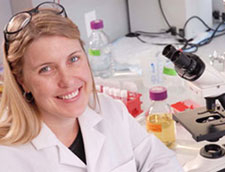
Dr. Matthew Porteus

Dr. Sara Sawyer The “Berlin patient,” cured of his HIV infection following a stem-cell transplant utilizing a donor harboring the genetic mutation known as CCR5 delta-32, established the concept that gene therapy—the use of genetically altered immune cells—is a promising approach to curing HIV/AIDS. However, the cost and potential side effects, which include death, of such an invasive procedure render it inappropriate for anyone not needing a transplant for additional reasons. The “Berlin patient” risked this procedure to treat his leukemia. Reporting recently in the April issue of the journal, Molecular Therapy, two amfAR-funded researchers suggest a safer and potentially more accessible approach—using a person’s own genetically modified immune cells.
amfAR grantees, Drs. Matthew Porteus of Stanford and Sara Sawyer of the University of Texas at Austin, used an enzyme known as a zinc finger nuclease to insert a cocktail of anti-HIV factors into T cells. They used the enzyme to cut the CCR5 gene and then inserted the genes for up to three anti-HIV factors into the gap created by the initial cut. They compared the resistance of the modified cells to HIV under each combination of conditions; either with the destruction of CCR5 alone, or with the addition of one, two, or three anti-HIV genes. The authors state, “this strategy provides multiple parallel blocks to infection, dramatically limiting pathways for viral escape.” With the addition of each new factor, the resistance of the cells to infection increased.
The technique, which Porteus and his colleagues characterize as “stacking,” mimics the cocktail of anti-HIV drugs used with highly active antiretroviral therapy (HAART), which is now the mainstay of HIV treatment. When all of the factors were present, it provided “virtually complete protection” against infection by the two major strains of HIV type 1, R5 and X4. The next step is to perform the same procedure not just in laboratory grown T cells, but in a patient’s own immune cells—either T cells or, ultimately, stem cells.
Dr. Laurence is amfAR’s senior scientific consultant.
Dr. Johnston is amfAR’s vice president and director of research.